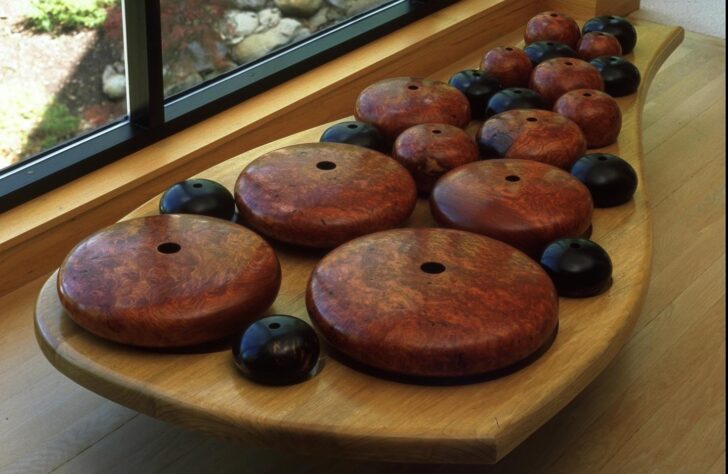Stones from the River, table base
Dan Kvitka

Description
March 28, 2009
Dan Kvitka is a wood artist who turns hollowed vessels from rare exotic specimens. Though traditionally vessels are functional, here they become sculpture—beautiful, polished, shiny smooth “stones,” the surface of which almost denies their substance. In Stones from the River, a collection of turned wood vessels is arranged along a horizontal support in a sculptural interpretation of the Judaic practice of Tashlich, which means “casting away.” The word is derived from a Biblical verse, “You will cast all their sins into the depths of the sea,” recited on the afternoon of Rosh Hashanah (Jewish New Year). The custom begins with a prayer, and then participants toss crumbs of bread or stones into a body of, preferably, moving water as a symbol of ridding themselves of the previous year’s sins. Dan Kvitka explains that “the orange ‘afzelia burl’ are the stones in the river…The ‘black ebony’ stones are the Tashlich stones, the stones containing both dark and light; they are us.”Dan Kvitka received a degree in industrial design from Art Center College of Design in Pasadena. He sees himself as part of a continuum of artists who have worked in wood: "The significance of the vessel, both functional and decorative, had for millennia attached us to who we are and where we have come from. Working in wood creating vessels gives me a sense of place within this history."
Themes of connection to past and ongoing traditions clearly appear in Stones from the River. The piece alludes to the Judaic tradition of Tashlich, during which sins are metaphorically tossed into a river. Kvitka and his wife participate in this tradition by tossing stones symbolizing their sins into a neighborhood stream, and have added to it by naming their dreams for the new year as well. According to Kvitka, “the orange ‘afzelia burl’ are the stones in the river; the pattern and movement of the grain mimics the whole piece… The ‘black ebony’ stones are the Tashlich stones, the stones containing both dark and light; they are us.”
from the exhibition Nature Transformed: Wood Art from the Bohlen Collection, June 12 – October 3, 2004
Usage Rights:
If you are interested in using an image for a publication, please visit https://umma.umich.edu/request-image/ for more information and to fill out the online Image Rights and Reproductions Request Form.